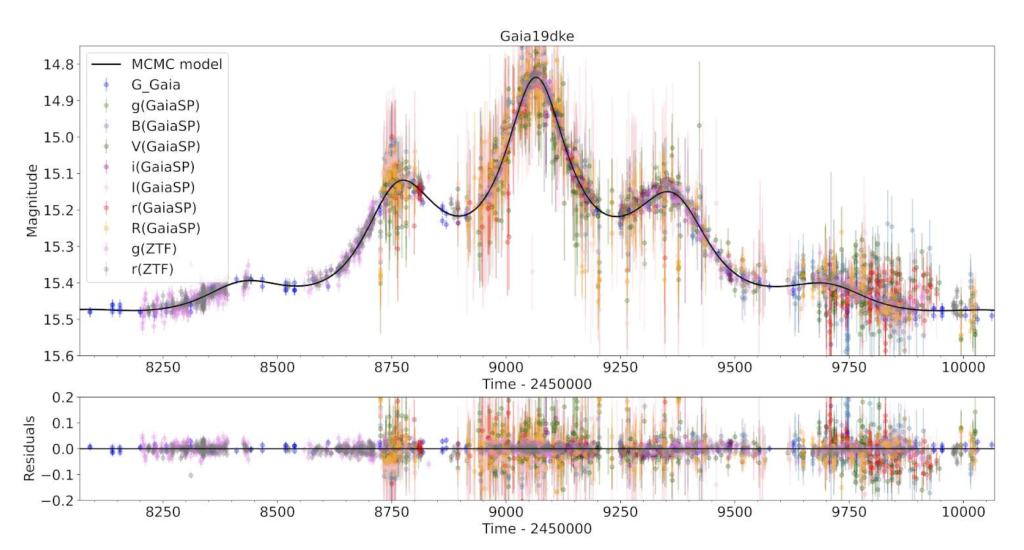Get to know the lens Gaia19dke

Stellar magnifying glass
Gravitational microlensing is a phenomenon in which a foreground star (“lens”) moves in front of a more distant star (“source”) seen from Earth. Gravity of the lens star works like a stellar magnifying glass, bending and amplifying the light of the background star. This brief brightening may disclose information about both stars – especially the concealed lens.
Per the authors: “Brightness curve of gravitational microlensing of Gaia19dke with data from the Gaia space observatory and supplementary information gathered by ground observatories, from JD = 2458062 to JD = 2460062. The black line is the brightness curve model obtained through MCMC modeling. The bottom panel presents residues of fitting the model to the data.”
Get to know Gaia19dke
In the above study astronomers focused on a particular episode of microlensing called Gaia19dke. This event, discovered by the European Space Agency’s satellite Gaia, stood out because it had an extreme parallax signal – an effect in which researchers can compare measurements of the event from various observation spots (on Earth or in space) to more accurately estimate distances and masses. Such events of “extreme parallax” are relatively rare but incredibly valuable because they help break through uncertainties that often plague researchers while studying microlensing phenomena.
Why the parallax matters
Parallax is a phenomenon in which the view of the object changes when you look at it from various points of view. In day-to-day life, closing one eye and then the other makes nearby objects seem to change their position. In the case of microlensing, having data from many observatories (or from Gaia in space and telescopes on Earth) changes perspective in a similar way. It is no different when we observe a phenomenon for a very long time (the Gaia19dke phenomenon has been observed for 5 years!). The observer (i.e. us) moves in relation to the source of radiation, thus “closes one eye and opens the other”, observing the phenomenon at a slightly different angle. This in turn translates into the measurement of how far away the lens star is and how massive it must be to create an observable bending of light.
Weighing the lens
Thanks to this extreme parallax, researchers could estimate the mass of the lens star in Gaia19dke with greater confidence (or with less error) than usual. The lens is probably located in the galactic disk, which means it is located in the vast, flat region of the Milky Way in which our Sun revolves as well. Estimating the mass of the star helps to determine its nature – whether it is an average star, like the Sun, a smaller red dwarf, or even a stellar remnant, such as a white dwarf. In the case of Gaia19dke, the lens probably was a small average star, but we cannot rule out also a white dwarf or even a small neutron star.
Insight into the Galaxy
Exact measurements of the mass of the lens allow not only to characterize a single star. They aid astronomers in perfecting general mass distribution and models of stellar population in the Galaxy disc. Each microlensing event that is precisely measured offers a unique element of the puzzle: how stars (and potentially hidden objects) populate our Milky Way, from bright suns to dark stellar remnants, including exotic black holes.
Looking ahead
Future instruments and studies will pay attention to such events as Gaia19dke. New telescopes with broader fields of view – along with the recently completed work of the Gaia mission and planned future missions – will probably catch more such extreme cases of parallax, which will lead to more accurate and frequent measurements of stellar masses. After all, those studies take us a step closer to obtaining a clearer image of the crowded and complex environment that we call our home in the Galaxy.
Observations of the objects were carried out by dozens of telescopes united in the observatory network BHTOM.space, a member of which is also the Astronomical Observatory of the University of Wrocław in Białków, while our researchers play a significant role in the entire BHTOM project.
P. J. Mikołajczyk and K. Kotysz’s participation in the research was supported by the OPTICON-RadioNet Pilot project funded by the European Union’s Horizon 2020 innovation and development program (grant agreement no. 101004719).
Bibliographical information: publication Lens Mass Estimate in the Galactic Disk Extreme Parallax Microlensing Event Gaia19dke by Maskoliūnas, M.; Wyrzykowski, Ł.; Howil, K.; Mikołajczyk, P. J.; Zieliński, P.; Kaczmarek, Z.; Kruszyńska, K.; Jabłońska, M.; Zdanavičius, J.; Pakštienė, E.; Čepas, V.; Rybicki, K. A.; Janulis, R.; Stonkutė, E.; Gromadzki, M.; Ihanec, N.; Adomavičienė, R.; Šiškauskaitė, K.; Bronikowski, M.; Sivak, P.; Stankevičiūtė, A.; Sitek, M.; Ratajczak, M.; Pylypenko, U.; Gezer, I.; Awiphan, S.; Bachelet, E.; Bąkowska, K.; Boyle, R. P.; Bozza, V.; Brincat, S. M.; Burgaz, U.; Butterley, T.; Carrasco, J. M.; Cassan, A.; Cusano, F.; Damljanovic, G.; Davidson, J. W.; Dhillon, V. S.; Dominik, M.; Dubois, F.; Esenoglu, H. H.; FigueraJaimes, R.; Fukui, A.; Galdies, C.; Garofalo, A.; Godunova, V.; Güver, T.; Hansdorfer, F.; Heidt, J.; Hundertmark, M.; Izviekova, I.; Joachimczyk, B.; Kamińska, M. K.; Kamiński, K.; Kaptan, S.; Kvernadze, T.; Kvaratskhelia, O.; Kotysz, K.; Littlefair, S.; Michniewicz, O.; Nakhatutai, N.; Ogłoza, W.; Ohsawa, R.; Olszewska, J. M.; Poleski, R.; Polińska, M.; Popowicz, A.; Qvam, J. K. T.; Radziwonowicz, M.; Reichart, D. E.; Słowikowska, A.; Simon, A.; Sonbas, E.; Stojanovic, M.; Szkudlarek, M.; Tsapras, Y.; Vanaverbeke, S.; Wambsganss, J.; Wilson, R. W.; Zola, S., Acta Astronomica, vol 74, no 2, p. 77-111, November 2024
